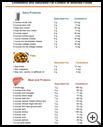
High Cholesterol
________________________________________________________________________
KEY POINTS
- Your body makes some cholesterol, and you get the rest from foods such as meats, dairy products, and eggs.
- Eating a diet high in fiber and low in saturated fat and cholesterol, losing weight, and exercising can help lower your cholesterol levels.
- Your healthcare provider may give you cholesterol-lowering medicine.
- Get your cholesterol levels checked by your healthcare provider regularly.
________________________________________________________________________
What is cholesterol?
Cholesterol is a type of fat. You have two sources of cholesterol. Your body makes some cholesterol and you get the rest from foods such as meats, dairy products, and eggs.
Cholesterol has both good and bad effects on the body. Your body uses cholesterol to make hormones and to build and maintain cells. When your body has too much cholesterol, fatty deposits called plaque may build up in blood vessels and make them narrower. The narrowing decreases the amount of blood flow through the vessels. Plaque also increases the chance that blood clots may form and block a blood vessel, which can cause a heart attack or stroke. The main types of cholesterol are LDL (low-density lipoprotein) and HDL (high-density lipoprotein).
- LDL leaves behind fatty deposits on artery walls and contributes to heart disease. LDL is called bad cholesterol. You can think of "L" for "lousy" cholesterol.
- HDL does the opposite. It cleans the artery walls, removes extra cholesterol from the body, and lowers the risk of heart disease. HDL is called good cholesterol. Think of "H" for "healthy" cholesterol.
High levels of LDL and low levels of HDL increase your risk for heart disease.
What causes high cholesterol?
Causes of high cholesterol include:
- Eating a diet that is high in saturated fat or cholesterol, like butter, meat, poultry fat, and some oils
- Being overweight or obese
- Not being physically active
- Having an inherited problem with the way your body makes or manages cholesterol
- Some medical conditions can raise your cholesterol level, such as diabetes, low thyroid levels, kidney disease, or liver disease
What are the symptoms?
High cholesterol does not cause any symptoms until it builds up in the artery walls and starts blocking blood flow. When this happens, depending on where the blockage is, you may have pain in your calf muscles when you walk or the chest pain of a heart attack. Sometimes there are no symptoms before a heart attack or stroke occurs.
How is it diagnosed?
A blood test can measure your total cholesterol, HDL, and LDL levels. The test usually includes triglyceride levels. Triglycerides are another type of fat in the blood.
Your healthcare provider will consider your risk factors for heart disease and your cholesterol levels before recommending treatment. Factors include your age, whether you are male or female, whether you smoke, your weight, your blood pressure, whether you have diabetes or other health problems, and whether high cholesterol or heart disease runs in your family.
How is it treated?
The goal of most cholesterol treatments is to lower your risk for heart disease. If you have a high risk, your healthcare provider may prescribe cholesterol-lowering medicine as well as changes in your lifestyle.
Changes in your lifestyle and medicines can:
- Lower the LDL in your blood. Lowering your LDL may slow or stop the fatty buildup (plaque) in your blood vessels. It may even help remove some of the buildup that is already there. The lower your LDL is, the lower your risk for heart attack and stroke.
- Raise the HDL in your blood. Raising your HDL helps your body get rid of harmful blood fats. HDL helps keep other types of cholesterol from sticking to the walls of your blood vessels and causing blockages.
How can I take care of myself and prevent high cholesterol?
- Limit the amount of saturated and trans fat that you eat. Saturated fat is found in whole milk, cheese, butter, ice cream, cream, lard, fatty cuts of meat, poultry with the skin on, and some tropical vegetable oils, such as coconut and palm kernel oil. Trans fat may be found in stick margarine, shortening, french fries, cookies, crackers, and bakery goods. If the food label has the words "partially hydrogenated," the product probably has trans fat.
- Get more exercise, especially aerobic exercise. Ask your provider to give you a physical activity plan that tells you what kind of activity, and how much, is safe for you. Start slowly to avoid injury.
- Don’t smoke and avoid secondhand smoke. Smoking lowers your HDL and increases your risk for heart disease in other ways as well.
- Limit alcohol to no more than 2 drinks a day for men and 1 drink a day for women.
- Lose weight if you are overweight and keep a healthy weight. Even a 10% weight loss may lower your cholesterol, and lower your blood sugar and blood pressure, if they are also too high. A 10% weight loss would be 20 pounds if you weigh 200 pounds.
- Get your cholesterol levels and weight checked as often as recommended by your healthcare provider.

